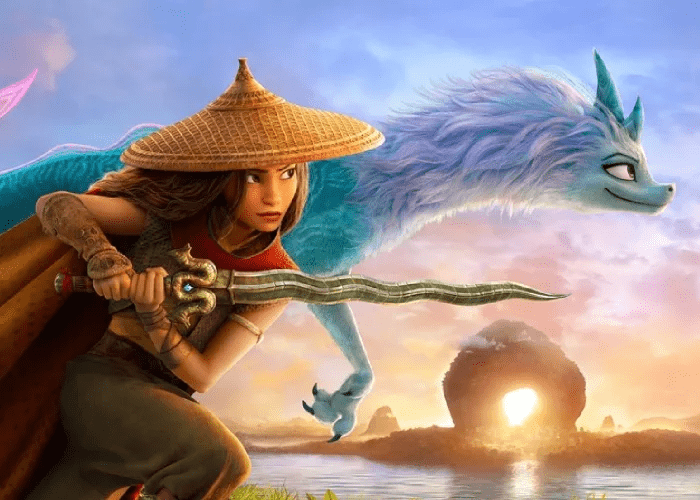
If there’s one thing Disney knows how to do well, it’s creating good movies. Moving, funny, insightful and entertaining films at the same time.
However, Disney’s reputation was largely built on its Eurocentric films, with the majority of these stories starring white characters. But, as awareness of the importance of diversity grew, the call for inclusion began.
It began when they responded to the call of people of color (POC) and released “The Princess and the Frog” in 2009, a significant step towards inclusion, since its protagonist, Tiana, was the first African-American Disney princess in history. Over the past decade, Disney has expanded its inclusion with culturally diverse stories like “Moana,” which portrays Polynesian culture, and its most recent release “Encanto,” which highlights the vibrant colors and music of Colombia.
Finally, Disney has not left out Asian representation. These films beautifully capture and portray stories and cultural nuances of the region through excellent visual storytelling and character design.
Mulan (1998)
Mulan, the boss girl of the Disney princesses, showed us that we can do and be anything, even a warrior in the imperial army. Based on the real Chinese legend “Hua Mulan”, this story revolves around a young girl who disguises herself as a man to take her father’s position in the army.
What makes this film great is that it represents Chinese culture through its discourse of honor, courage and truth. The war in the film reflected the long-running conflicts between Central China and the invading Huns of the northern border, a nod to the country’s history. Additionally, the film’s animation style paid homage to the Chinese art of watercolor, often seen in Chinese paintings.
Mulan also challenged gender stereotypes, as in feudal China women were expected to be one thing: good wives. The scene in which she prepares to meet with a matchmaker is very real, from her traditional makeup to the small cricket she carries, a creature considered to be lucky and prosperous in her culture.
Disney+ advances Korean dramas for 2024-2025
And speaking of little creatures, Mushu, Mulan’s companion, is a dragon, a famous character from Chinese mythology.
Only they are… bigger. (Sorry, Mushu! Disgrace to us and our cows!) A live-action remake starring Yifei Liu was released in 2020, featuring an incredible cast and action-packed scenes. Also notable was another creature from Chinese folklore, the Phoenix, which was often considered the symbol of the Empress or female members of the royal family.
Big Hero 6 (2014)
Japan and America meet in this adaptation of the comics created by Man of Action, and published by the powerful superhero publisher Marvel. In addition, it is the first Disney animated film to feature Marvel Comics characters.
In “Big Hero 6” we are introduced to Hiro Hamada, a 14-year-old robotics genius, and Baymax, the healthcare robot created by Hiro’s older brother, Tadashi Hamada, who died in a fire accident. In the film, Hiro and Baymax team up and form a team of superheroes to combat a masked antagonist who plans to take over Hiro’s invention and who could be responsible for Tadashi’s death (dun dun duuun!).
The film portrays characters with a mixed cultural heritage, as Hiro is half Japanese. This is also reflected in the hybrid urban setting called San Fransokyo. Architectural alchemy accentuates it by combining urban elements from San Francisco and the eclectic Japanese capital. In the film, you can see neon-screened Shibuya skyscrapers hugging San Francisco’s iconic Transamerica Pyramid, and Victorian Mission duplexes lining mountain neighborhoods complemented by blooming Japanese cherry trees along the streets.
Even the Baymax robot’s features resemble Hello Kitty’s, with its round eyes and soft white exterior. These little details show two on-screen cultures sharing the same world, and certainly earn Disney some points for diversity.
Float (2019)
This Pixar animated short is the first to feature CGI Filipino-American characters. “Float” tells the story of a Filipino father who discovers that his young son has the ability to float. In this short film of about seven minutes, the father tries to keep this ability a secret, but when it is discovered, he must decide whether to run away or accept his son as he is.
The short film was written and directed by Filipino storyboard artist Bobby Alcid Rubio, who revealed that the story was inspired by his relationship with his son Alex, who has autism. Thus, not only Filipino characters appear, but also people with developmental disabilities.
The film was developed under SparkShorts, an immersive storytelling program that gives Pixar studio employees six months and a budget to develop animated short films. This show in itself is a great example of how Disney is pushing for diversity and championing more stories from different parts of the world.
Speaking of Filipino movies, Disney UK released a Christmas ad in 2020 with a heartwarming Christmas story between a Lola (Filipino term for grandmother) and her granddaughter as part of their “From Our Family to Yours” series. Tears still come to our eyes today.
Raya and the last dragon (2021)
Another film that inspired diversity and inclusion in the Disney Princess line is “Raya and the Last Dragon,” which features representation of Southeast Asian culture. The film tells the story of Raya, a lonely warrior princess who searches for the last dragon to save her homeland, Kumandra, from the evil Druun. Throughout the film, he learns to open up and trust others, realizing that leaning on them is the only way to save his homeland.
There are many cultural details present in the film, from the smallest things, such as characters taking off their shoes before entering someone’s home, to larger attributes, such as the representation of family and community values, visible throughout the entire movie.
Another reflection of cultural authenticity is the character of Sisu, who is not your typical fire-breathing dragon. In Southeast Asia, dragons are more aquatic deities called naga and are creatures that bring good omens. Another example of a water dragon in Southeast Asian folklore is the Bakunawa, the serpent-like dragon that ruled the oceans in Philippine mythology.
These films beautifully capture and portray stories and cultural nuances of the region through excellent visual storytelling and character design.
Disney revealed that to ensure cultural authenticity, the filmmakers formed a group of Southeast Asian cultural experts and even traveled to Laos, Indonesia, Thailand, Vietnam, Cambodia, Malaysia and Singapore for inspiration. The film’s creative team was also made up of people from Southeast Asia who shared their stories and contributed details to the film.
Adele Lim, author of the script, told Disney: “When you really look at what makes our culture amazing, whether it’s our arts or our food, the best street food in the world, it’s because all of these different elements come together.” really and create something transcendent.
Turning Red (2022)
This coming-of-age film is a milestone for Pixar Animation Studios as it is the first directed by a woman and the second with an Asian lead; the first was Russel, from “Up”, in 2009. “Turning Red” is another film that addresses mixed cultural heritage, since its protagonist, Meilin “Mei Mei” Lee, is a 13-year-old Chinese-Canadian who is experiencing the problems of puberty.
If you think you did wrong, think again. While most of us suffer from mood swings, acne breakouts, and teen angst, Mei Mei turns into a giant red panda whenever she feels a strong emotion. Yes, we are talking about a huge red furry creature.
There is a lot to like about “Turning Red,” including its fun characters and humorous depiction of what happens in a teenage girl’s life, which mostly consists of surviving high school, arguing with parents, and flirting with husbands. What makes this film stand out, however, is its clever take on menstruation, a topic not seen much in coming-of-age films.
Additionally, the film conveys the emotional complexities between mother and daughter, especially in Asian families. Director Domee Shi (the same one behind the Pixar short “Bao”) explained in an article that Western coming-of-age stories are more “black and white,” in which parents are portrayed as villains than their children. They have to free themselves to follow their dreams or find themselves.

Collaborator at ReporteAsia.
Source: https://reporteasia.com/cultura/cultura-pop/2024/09/27/representacion-asiatica-cine-disney-diversidad-animacion/

